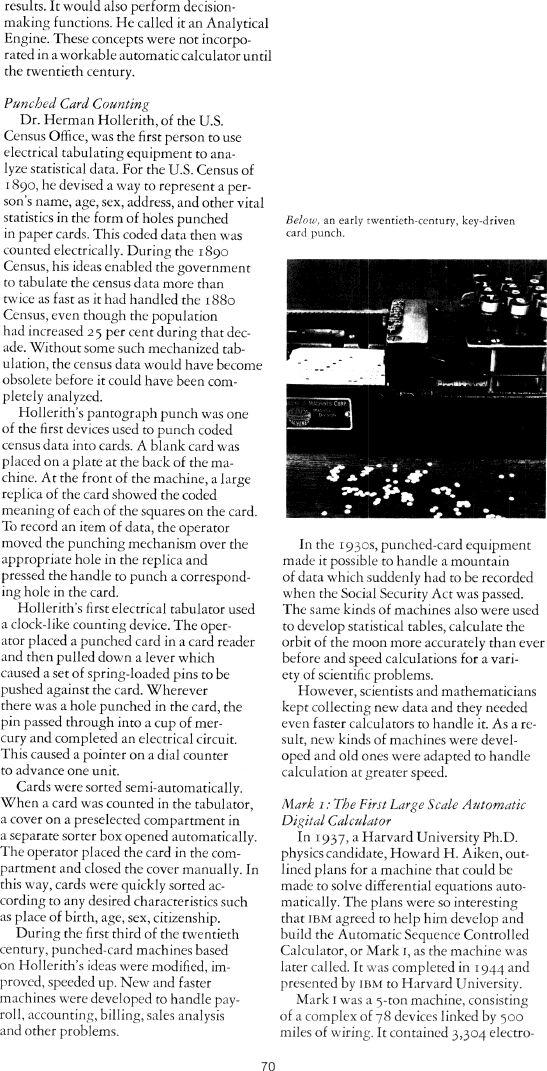The Best of Creative Computing Volume 1 (published 1976)
Digital Calculators - Then And Now (punched card counting, Harvard Mark I)

results. It would also perform decisionmaking functions. He called it an
Analytical
Engine. These concepts were not incorporated in a workable automatic calculator
until
the twentieth century.
***
Punched Card Counting
Dr. Herman Hollerith, of the U.S.
Census Office, was the first person to use
electrical tabulating equipment to analyze statistical data. For the U.S. Census
of
1890, he devised a way to represent a person's name, age, sex, address, and
other vital
statistics in the form of holes punched
in paper cards. This coded data then was
counted electrically. During the 1890
Census, his ideas enabled the government
to tabulate the census data more than
twice as fast as it had handled the 1880
Census, even though the population
had increased 25 per cent during that decade. Without some such mechanized
tabulation, the census data would have become
obsolete before it could have been completely analyzed.
Hollerith's pantograph punch was one
of the first devices used to punch coded
census data into cards. A blank card was
placed on a plate at the back of the machine. At the front of the machine, a
large
replica of the card showed the coded
meaning of each of the squares on the card.
To record an item of data, the operator
moved the punching mechanism over the
appropriate hole in the replica and
pressed the handle to punch a corresponding hole in the card.
Hollerith's first electrical tabulator used
a clocklike counting device. The operator placed a punched card in a card reader
and then pulled down a lever which
caused a set of springloaded pins to be
pushed against the card. Wherever
there was a hole punched in the card, the
pin passed through into a cup of mercury and completed an electrical circuit.
This caused a pointer on a dial counter
to advance one unit.
Cards were sorted semiautomatically.
When a card was counted in the tabulator,
a cover on a preselected compartment in
a separate sorter box opened automatically.
The operator placed the card in the compartment and closed the cover manually.
In
this way, cards were quickly sorted according to any desired characteristics
such
as place of birth, age, sex, citizenship.
During the first third of the twentieth
century, punchedcard machines based
on Hollerith's ideas were modified, improved, speeded up. New and faster
machines were developed to handle payroll, accounting, billing, sales analysis
and other problems.
Below, an early twentiethcentury, keydriven
card punch.
In the 193OS, punchedcard equipment
made it possible to handle a mountain
of data which suddenly had to be recorded
when the Social Security Act was passed.
The same kinds of machines also were used
to develop statistical tables, calculate the
orbit of the moon more accurately than ever
before and speed calculations for a variety of scientific problems.
However, scientists and mathematicians
kept collecting new data and they needed
even faster calculators to handle it. As a result, new kinds of machines were
developed and old ones were adapted to handle
calculation at greater speed.
***
Mark 1: The First Large Scale Automatic
Digital Calculator
ln 1937, a Harvard University Ph.D.
physics candidate, Howard H, Aiken, outlined plans for a machine that could be
made to solve differential equations automatically. The plans were so
interesting
that IBM agreed to help him develop and
build the Automatic Sequence Controlled
Calculator, or Mark 1, as the machine was
later called. It was completed in 1944 and
presented by IBM to Harvard University.
Mark 1 was a 5ton machine, consisting
of a complex of 78 devices linked by 500
miles of wiring. It contained 3,304 electro


